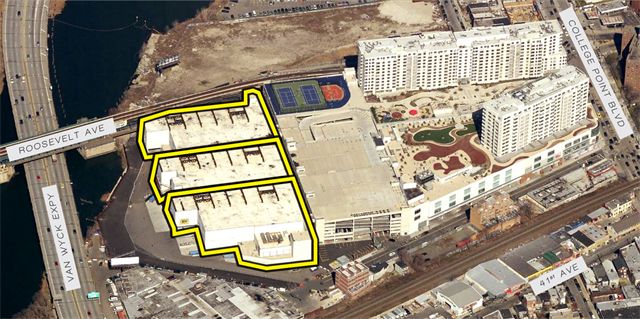Over the past few years we’ve seen numerous mega developments throughout Queens including Sky View Parc and Flushing Commons. The Willets Point development site, which has received much hype over the past couple years however, sits silent with no shovels in the ground.
In late 2013, the Willets Point site was approved for a 61-acre development with plans to include a shopping mall, a convention center, mixed-income housing, and other uses. Since then several lawsuits have stymied the chances of the project happening at all. Politicians and other lobbyists have questioned the legality of developing the project due to the location technically being part of the Flushing Meadows-Corona Park. They have also pointed out that many merchants in Willets Point would be displaced with the project. It is true that merchants would be displaced, but there are services like English language and job training and placement available to the Willets Point workers at no cost to them to offset that. The project will also create thousands of permanent jobs, and give an enormous boost to the local economy. Specifically, in July of this year Sterling Equities was dealt a big blow when the NYS court shot down the Willets Point project, and in August they suffered yet another blow when Mayor de Blasio’s administration did not participate in the appeal of the court’s July ruling. Somewhat surprisingly, the NYS Court of Appeals agreed before Thanksgiving to hear Sterling Equities’ appeal of the decision to shut down the project. So again, Sterling Equities and its developer Related Companies sit waiting.
Beyond Willets Point, Queens has seen a slowdown in the development market. There have been very few development sites of large capacity traded in the past six months as compared to the past couple of years where developers were acquiring sites very aggressively. For a number of reasons buyers and developers have shown less urgency and more caution. Some would say it’s the interest rate threat and others may sense a market peak in sight, if it hasn’t passed already. Another indication of why buyers and developers have visibly slowed down is the uncertainty of the status of the 421a tax abatement.
The 421a tax abatement program has been around since the 1970s, but it has been a hot topic recently because the program was set to expire on June 26, but was extended through Dec. 31 of this year with uncertain future conditions. What the abatement does is give developers significantly lower property taxes. Properties can receive exemptions for up to three years during the construction phase of development for all increases in property taxes, as well as up to 25 years of abatement after completion. The new amendments to the program proposed by the State of New York include a mandate that all properties receiving the abatement in the future must include 25-30 percent affordable housing units. To balance this out the maximum tax exemption period would increase from 25 to potentially 35 years. The amendment to the program extended the law until June 15, 2019 contingent upon labor and real estate groups addressing wage protections for construction workers before Jan. 15, 2016. The mayor excluded construction workers from his plan to set a wage rate for service jobs in 421a buildings because higher wages could jeopardize close to 25,000 affordable units that are anticipated to be built based on the current program.
Developers are left twiddling their thumbs, waiting to see what will happen with the tax abatement before they move forward on their projects. A decision has yet to be made as the clock ticks away with the deadline looming. In our normal business activity and relationships with developers it seems the general consensus is that nobody really knows what to expect. The insecurity of the situation could be a significant reason why development has slowed in terms of activity and demand.



































